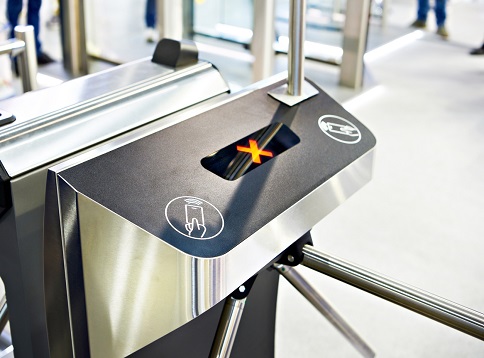A Guide to Access Control Card Readers and Keypads
24 November 2021

An access control system consists of several components but one of the most critical is the access control reader. These are possibly the most visible part of an access control system and have to satisfy several criteria. Apart from fitting in well with the décor and space available near to the doors they control, their data integrity must be secure, they must be durable and resilient, and be easy to upgrade if there is a need to apply firmware updates and add additional functionality.
What is an Access Control Reader?
An access control reader ‘reads’ the credential presented and checks this to the database within the access control software. If access to a specific doorway is allowed for that credential, the door is opened and if not, the door remains locked. The card reader may be a standalone wall mounted device or built-into an entrance turnstyle.
The most common carrier of a credential is an access control card or key-fob. The card contains a microprocessor and aerial and is energised (powered) when brought within a couple of millimetres of a compatible card reader. A card reader, such as EntroPad, can also be supplied with a built-in keypad to allow two-factor authentication. When the card has been read, the holder can enter a pin-code. Door entry can only be achieved through presentation of the correct credential and pin-code. Without both, access is denied.
Credentials can also be presented to compatible readers in other forms, some of which may also offer multi-factor authentication (MFA). Example include biometric readers and mobile phone credential reads. Types of biometric credentials include fingerprints, palms, iris and faces (for recognition). Mobile phone credentials are typically stored in an App on a mobile device and managed through a cloud-based platform.
Key Considerations for Access Control Card Readers
The choice of which card readers to deploy can literally make or break an access control system. The choice has to be made on the most appropriate technology and level of security required. The readers also have to be extremely reliable in operation and easy to use. There is nothing more frustrating when trying to use an access-controlled door, than for a reader to prevent access. Access should only be denied when a credential holder does not have permission to use the door and not because of a fault in the reader or its reading of the credential.
Reader Aesthetics and Durability
The reader is one of the most visible parts of an access control system and may be installed inside or outside a building. The design of the reader has to be such that it is aesthetically pleasing and should blend into the building’s décor and corporate design. Outdoor installations will require a reader with a high IP (Ingress Protection) for weatherproofing from rain, dust and pollutants, and to a degree resistance to vandalism. These factors can also influence the choice of card reader for use internal to a building.
It may also be possible to customise the reader through matching colours to the organisation’s colour scheme. This may be feasible in terms of the plastic shell colours and designs available, or the choice of LED colours enabled.
Above all the access control reader chosen should be robust and of a design that will ensure 100% reliability and uptime.
Reader Data Security and Credential Protection
End-to-end security between access control readers, door controllers and the access control software are fundamental to the secure protection of a credential. If the credential can be read by a third party, they can theoretically clone the credential and gain access to a secure area.
Data integrity and security is provided through system encryption and authentication. TFA (Two Factor Authentication) provides another later of security. For cards and card readers a secure MIFARE technology should be considered. An access control system, such as the Remsdaq Entro access control system series, may also offer its own secure credential. For the Entro series, EntroPass offers 128-bit Advanced Encryption Standard (AES) for authentication, data integrity, and encryption and is a highly secure MIFARE Security Level 3 credential.
Reader Ease of Firmware and Feature Upgrade
An access-controlled door may have one or more card reader/keypads and even a request to exist button. It is important to be able to easily upgrade the firmware and control the functionality of these as a typical installation can last 10-15 years or more. With an EntroPad, programming cards can be pre-configured with the latest firmware and features and presented to each reader. RFID (Radio-frequency Identification) is used in the same was as with an access control card, the read the firmware and feature changes and the EntroPad is updated to the required functionality.
Summary
Access control systems are installed to secure a building, the people and assets within it. Card readers are a fundamental component and are the most visible part of an access control system. Installed readers should offer a high level of encryption, upgradability and be durable enough to withstand years of use and even potential tampering. It is important to ensure data integrity and security are maintained at all times and that there is no potential for degradation.
An often-overlooked area for most access control systems is credential management, especially where an organisation does not have their access control system maintained. Credentials should be reviewed and unused credentials expired. Visitors and temporary contractors are classic examples where a time limited pass is required. Some systems allow for this automatically and in others manual intervention is required.
